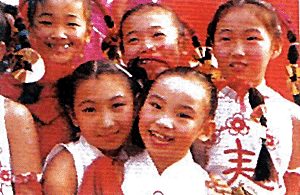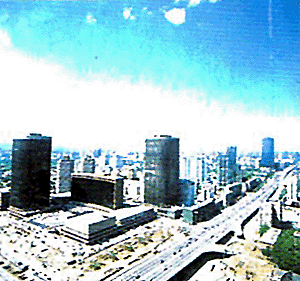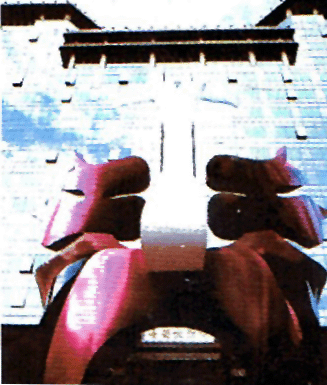|
 Beijing is the historic cultural
city well known in
the world and has
been becoming
the capital of the
People's
Republic of China
ever since 1949.
As the cultures, landscapes, and historic relics are
concentrated here, Beijing is the tourist resort that
attracts all the people from the world Beijing is the historic cultural
city well known in
the world and has
been becoming
the capital of the
People's
Republic of China
ever since 1949.
As the cultures, landscapes, and historic relics are
concentrated here, Beijing is the tourist resort that
attracts all the people from the world
Historical evolution
Five hundred thousand years ago, primitives lived in
Zhoukoudian in the southwest 50 km away from Beijing
and are named Peking Man who were the earliest
residents of the region. The earliest written history of
Beijing can be traced to 3000 years ago. In 586 BC, the
Feud Yen of Zhou Dynasty established Yan State and
made this place ifs capital and named it as ji City.
Beijing was thus called Yanjing afterward. After Yan was
conquered by Oin state, the city remained a place of
military importance in northern area. In early 10 century
AD, the people of Khitan nationality established Liao
Dynasty, and the city was made an alternate capital
then and renamed as Nanjing. In 1125, the Nuchen
nationality became prosperous and powerful. After they
conquered Liao and established Jin Dynasty, they
established the city officially as the capital of Jin
Dynasty and was named Zhongdu (Central Metropolis).
 A large-scale construction was carried out and 36
luxurious palaces were built here. The location of
Zhongdu is in area of Guang'an Men today, but
unfortunately it was burned out by mutinous soldiers in
1215. Just in the year, Mongolian began to invade
southwards. They seized Zhongdu and put an end to
Jin Dynasty. Before long, Mongolian troops wiped out
the Southern Song Dynasty and unified the whole
China. In 1267, the Yuan Dynasty was established and
this city was rebuilt as the capital and named as Dadu
(Grand Metropolis). Since then, Dadu of Yuan Dynasty
became the political center of the whole countrv. The
Yuan uynasty re-designed and rebuild a new City
centered at the Daning Palace, the detached palace of
Jin Dynasty (presently it is the Beihai Park), which was
located in the east suburb of Zhongdu of Jin Dynasty. A large-scale construction was carried out and 36
luxurious palaces were built here. The location of
Zhongdu is in area of Guang'an Men today, but
unfortunately it was burned out by mutinous soldiers in
1215. Just in the year, Mongolian began to invade
southwards. They seized Zhongdu and put an end to
Jin Dynasty. Before long, Mongolian troops wiped out
the Southern Song Dynasty and unified the whole
China. In 1267, the Yuan Dynasty was established and
this city was rebuilt as the capital and named as Dadu
(Grand Metropolis). Since then, Dadu of Yuan Dynasty
became the political center of the whole countrv. The
Yuan uynasty re-designed and rebuild a new City
centered at the Daning Palace, the detached palace of
Jin Dynasty (presently it is the Beihai Park), which was
located in the east suburb of Zhongdu of Jin Dynasty.
This formed the predecessor of old Beijing city. In 1368,
Zhu Yuanzhang overthrew the Yuan Dynasty and
established the Ming Dynasty. The capital was founded
in Nanjing in the southern China in the early period of
the Ming and Dadu was renamed as Beiping and those
imperial palaces of Yuan Dynasty were pulled down.
When Zhu Di took over the throne, he moved the capital
to Beiping and renamed it as Beijing in order to enforce
his rule in the north. The city was called Beijing hence.
With 20-year construction, the capital of the Ming
Dynasty was officially moved into Beijing. In the year of
1644 when the troops of
the Qing Dynasty invaded
through the northeastern
pass, the Ming Dynasty
was terminated and the
Qing Dynasty continued to
take Beijing as its capital.
After the People's
Republic of China was
founded on October 1st,
1949, Beijing becomes the
capital of new China.
Abundant historic sites and brilliant cultures
During such a long period of development, the people of many Chinese nationalities created brilliant cultures for Beijing. The world-famous Great Wall winds on lofty mountains and steep ridges in the northwest of Beijing.
 The intact architectural complex of the Forbidden City locates spectacularly in the center of whole city. Ancient historic relics, imperial mausoleums, tombs, stone inscriptions, ancient towers.temDles and so on spread all over Beijing such as the elaborated Lugou Bridge, famous ancient observatory and well-configured classic gardens which are bright reflections of Chinese people's intelligence. And what's more, the natural landscapes in the outskirts are picturesque and enchanting. The intact architectural complex of the Forbidden City locates spectacularly in the center of whole city. Ancient historic relics, imperial mausoleums, tombs, stone inscriptions, ancient towers.temDles and so on spread all over Beijing such as the elaborated Lugou Bridge, famous ancient observatory and well-configured classic gardens which are bright reflections of Chinese people's intelligence. And what's more, the natural landscapes in the outskirts are picturesque and enchanting.
Typical Beijing food and dishes have their own peculiar characteristics. A lot of famous Beijing delicacies, such as royal dishes Beijing roast duck, instant-boiled mutton and grilled meat not only have absorbed advantages of the dishes of the other regions, but also have created their own unique peculiarities. In various restaurants of Beijing, all the cuisines of the whole country and even the whole world can be appreciated here.
Beijing Today Present Beijing not only preserves me styles and features of the ancient city, but also develops it as a modern city in new era. Ancient and modem styles interweave and compose a charming and particular sight in Beijing.
The old Beijing city was carefully designed and constructed and its center was at the Forbidden City to form a neat, strict and beautiful configuration. Since 1949, especially after the policy of opening and reform was implemented in 1979, Beijing has developed into an emerging modem city.
 High-tech industries and scientific and cultural facilities develop rapidly; city construction changes quickly; and highways in outskirts extend in all directions. Based on the old city, nowadays Beijing has become several times bigger than that before in size. High-tech industries and scientific and cultural facilities develop rapidly; city construction changes quickly; and highways in outskirts extend in all directions. Based on the old city, nowadays Beijing has become several times bigger than that before in size.
Skyscrapers have been erupted from level ground one by one, more and more expresses are going to all quarters of the country, and the public traffic, subway and civil aviation are also continuously developed. Beijing is a modem and intemationalized metropolis with many museums, exhibition and memorial halls, big theaters, concert halls, recreation clubs and large department stores that attract tens of thousands of tourists every day.
Beijing people have the tradition of hospitality, and the changing and developing Beijing is looking forward to your visit.
|
Beijing Travel:
Yuandadu Ruins,
Yonghegong Lamasery,
White Cloud Taoist Temple,
Tian Anmen Gate Tower,
Temple Of Heaven,
Summer Palance,
Shihua Stone Flower Cave,
Ruins Of Yuanmingyuan,
Peking University,
Opera And Enterainment,
Olympic Stadium Outline,
Nine-Dragon Amusement Park,
New Flight Course Of Kunyu,
National Swimming Center,
National Stadium,
National Library Of China,
National Gymnasium,
Museum Of Chinese History,
Monument People Heroes,
Militarv Museum Chinese People's Revolution,
Louge Bridge,
Liu Li Chang Cultural Street,
Introduction Historical Beijing,
Grand View Garden,
Garden Prince Gong's Mansion,
Former Residence Of Mme Soong Cningiing,
Forbidden City,
China Millennium Monument,
China Fine Arts Gallery,
Chang An Theater,
Chairman Mao's Memorial Hall,
Big Bell Temple,
Beijingmuseum Of Nature,
Beijing Special Products,
Beijing Police Museum,
Beijing Ocean Aquarium,
Beijing Huangchenggen Ruins Park,
Beijing Botanical Garden,
Beiiing Snecial Artifacts,
Beihai Park,
Asian Game Village,
Ancient Observatory,
38 Tourist Routes In Regions Arouind Beijing,
Cultural attractions in Beijing (Peking),
24 Sightseeing Routes-In Beijing
|
Main Cities in China Travel and China Hotels







 Beijing Beijing  Canton Canton
 Shanghai Shanghai  Hong
Kong Hong
Kong  Qingdao Qingdao  Hangzhou Hangzhou |
Other Major Cities:
Changchun,
Chengdu,
Chongqing,
Dalian,
Dongguan,
Dunhuang,
Foshan,
Guangzhou,
Guilin,
Haikou,
Harbin,
Hainan,
Hangzhou,
Kunming,
Lhasa,
Macau,
Nanjing,
Qingdao,
Sanya,
Shenyang,
Suzhou
Shanghai,
Shenzhen,
Tianjin,
Weihai,
Wenzhou,
Xiamen,
Xi'an,
Yiwu
|
Major China Hotels:
Beijing Hotels,
Chengdu Hotels,
Chongqing Hotels,
Dalian Hotels,
Foshan Hotels,
GuangZhou Hotels,
Guilin Hotels,
Hangzhou Hotels,
Harbin Hotels,
HongKong Hotels,
Kunming Hotels,
Macau Hotels,
Nanjing Hotels,
Qingdao Hotels,
Sanya Hotels,
Shanghai Hotels,
Shenyang Hotels,
Suzhou Hotels,
Tianjin Hotels,
Urumqi Hotels,
Wenzhou Hotels,
Xiamen Hotels,
Xian Hotels |
|  |
|
 Beijing is the historic cultural
city well known in
the world and has
been becoming
the capital of the
People's
Republic of China
ever since 1949.
As the cultures, landscapes, and historic relics are
concentrated here, Beijing is the tourist resort that
attracts all the people from the world
Beijing is the historic cultural
city well known in
the world and has
been becoming
the capital of the
People's
Republic of China
ever since 1949.
As the cultures, landscapes, and historic relics are
concentrated here, Beijing is the tourist resort that
attracts all the people from the world A large-scale construction was carried out and 36
luxurious palaces were built here. The location of
Zhongdu is in area of Guang'an Men today, but
unfortunately it was burned out by mutinous soldiers in
1215. Just in the year, Mongolian began to invade
southwards. They seized Zhongdu and put an end to
Jin Dynasty. Before long, Mongolian troops wiped out
the Southern Song Dynasty and unified the whole
China. In 1267, the Yuan Dynasty was established and
this city was rebuilt as the capital and named as Dadu
(Grand Metropolis). Since then, Dadu of Yuan Dynasty
became the political center of the whole countrv. The
Yuan uynasty re-designed and rebuild a new City
centered at the Daning Palace, the detached palace of
Jin Dynasty (presently it is the Beihai Park), which was
located in the east suburb of Zhongdu of Jin Dynasty.
A large-scale construction was carried out and 36
luxurious palaces were built here. The location of
Zhongdu is in area of Guang'an Men today, but
unfortunately it was burned out by mutinous soldiers in
1215. Just in the year, Mongolian began to invade
southwards. They seized Zhongdu and put an end to
Jin Dynasty. Before long, Mongolian troops wiped out
the Southern Song Dynasty and unified the whole
China. In 1267, the Yuan Dynasty was established and
this city was rebuilt as the capital and named as Dadu
(Grand Metropolis). Since then, Dadu of Yuan Dynasty
became the political center of the whole countrv. The
Yuan uynasty re-designed and rebuild a new City
centered at the Daning Palace, the detached palace of
Jin Dynasty (presently it is the Beihai Park), which was
located in the east suburb of Zhongdu of Jin Dynasty. The intact architectural complex of the Forbidden City locates spectacularly in the center of whole city. Ancient historic relics, imperial mausoleums, tombs, stone inscriptions, ancient towers.temDles and so on spread all over Beijing such as the elaborated Lugou Bridge, famous ancient observatory and well-configured classic gardens which are bright reflections of Chinese people's intelligence. And what's more, the natural landscapes in the outskirts are picturesque and enchanting.
The intact architectural complex of the Forbidden City locates spectacularly in the center of whole city. Ancient historic relics, imperial mausoleums, tombs, stone inscriptions, ancient towers.temDles and so on spread all over Beijing such as the elaborated Lugou Bridge, famous ancient observatory and well-configured classic gardens which are bright reflections of Chinese people's intelligence. And what's more, the natural landscapes in the outskirts are picturesque and enchanting.  High-tech industries and scientific and cultural facilities develop rapidly; city construction changes quickly; and highways in outskirts extend in all directions. Based on the old city, nowadays Beijing has become several times bigger than that before in size.
High-tech industries and scientific and cultural facilities develop rapidly; city construction changes quickly; and highways in outskirts extend in all directions. Based on the old city, nowadays Beijing has become several times bigger than that before in size. 




